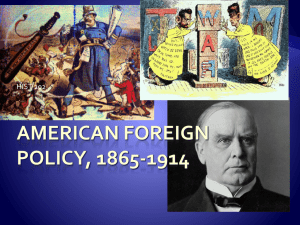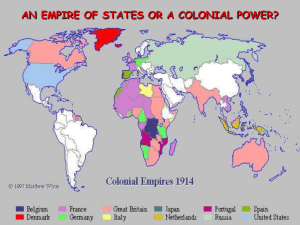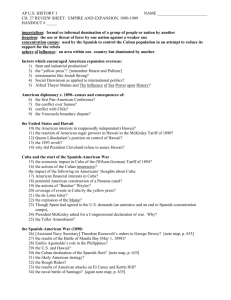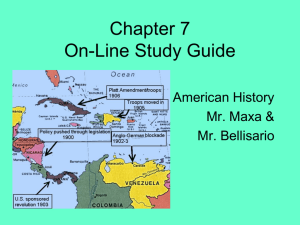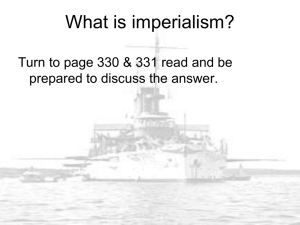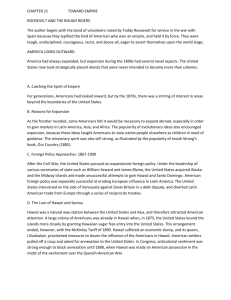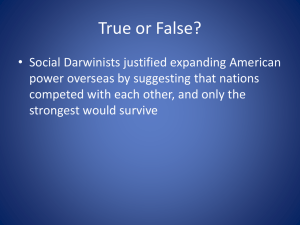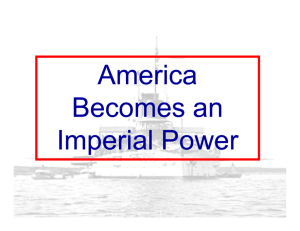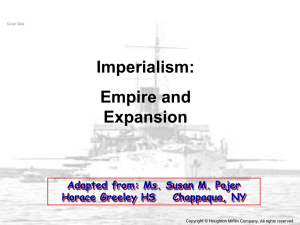File - AP US History
advertisement
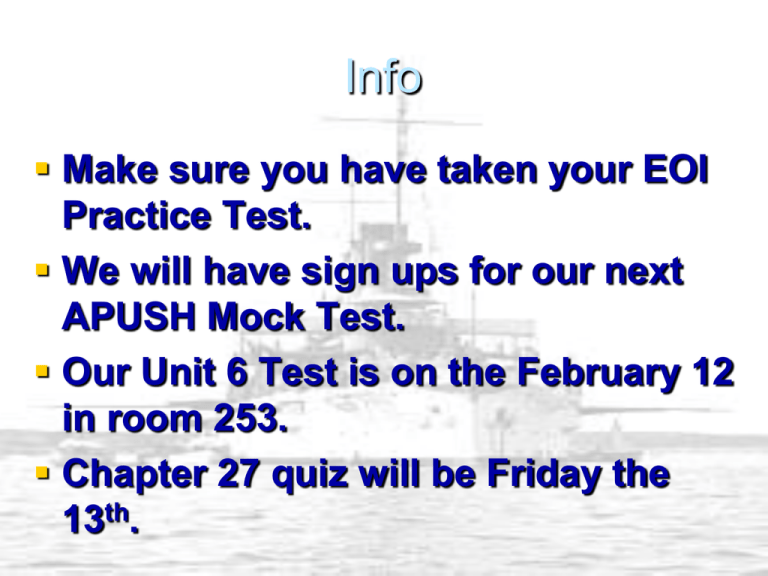
Info Make sure you have taken your EOI Practice Test. We will have sign ups for our next APUSH Mock Test. Our Unit 6 Test is on the February 12 in room 253. Chapter 27 quiz will be Friday the 13th. APUSH Chapter 27 Empire & Expansion 1. Commercial/Business Interests U. S. Foreign Investments: 1869-1908 2. Military/Strategic Interests Alfred T. Mahan The Influence of Sea Power on History: 1660-1783 Alfred T. Mahan U.S. Naval Officer U.S. must keep up with other nations that est. global military presence By 1890 U.S. is world’s 3rd largest navel power 3. Social Darwinist Thinking The Hierarchy of Race The White Man’s Burden 4. Religious/Missionary Interests American Missionaries in China, 1905 Cultural Superiority? U.S. thought American way of life is the best It was their duty to “Americanize” & Christianize the rest of the world 5. Closing the American Frontier U. S. Missionaries in Hawaii Why was Hawaii becoming increasingly important to the US in the 19th Century? Main industry to invest in? First Christian missionaries arrive in what year? Effect of the McKinley Tariff of 1890? Imiola Church – first built in the late 1820s U. S. View of Hawaiians Why did American sugar planters have to import laborers from other countries? Results? By 1900 foreigners outnumber Hawaiians 3 to 1 Hawaii becomes a U. S. Protectorate in 1849 by virtue of economic treaties. Hawaiian Queen Liliuokalani Hawaii for the Hawaiians! U. S. Business Interests In Hawaii 1893 – American businessmen backed an uprising against Queen Liliuokalani. U.S. Marines are sent in to “protect” Americans in Hawaii, actually help overthrow the Queen Sanford B. Dole proclaims the Republic of Hawaii in 1894. Sanford B. Dole To The Victor Belongs the Spoils Hawaiian Annexation Ceremony, 1898 Essential Question: Why did American expansionism during the turn of the century result in the Spanish-American War and the war in the Philippines? Spanish Misrule in Cuba The Imperialist Tailor Cuba Libre During the 1800s Cuba repeatedly tries to gain independence from Spain Why does this concern the USA? Americans invest millions in Cuban Sugar plantations Rebels hoping for Cuban independence began a revolution and destroyed property owned by Spanish and Americans in Cuba “Yellow Journalism” Sensationalizes & exaggerates headlines to sell newspapers Joseph Pulitzer Hearst to Frederick Remington: William Randolph Hearst You furnish the pictures, and I’ll furnish the war! Valeriano Weyler’s “Reconcentration” Policy How would the actions of Weyler encourage yellow journalism? Nicknamed “The Butcher” 300,000 Cubans in concentration camps De Lôme Letter Jingoism??? Extreme patriotism in the form of aggressive foreign policy. Dupuy de Lôme, Spanish Ambassador to the U.S. Criticized President McKinley as weak and a bidder for the admiration of the crowd, besides being a would-be politician who tries to leave a door open behind himself while keeping on good terms with the jingoes of his party. Remember the Maine and to Hell with Spain! 1898: ship mysteriously blows up in Havana Harbor Funeral for Maine victims in Havana The Spanish-American War (1898): “That Splendid Little War” Effects of location? Effects of climate? Key Battles: Kettle Hill San Juan Hill How prepared was the US for war? Theodore Roosevelt Assistant Secretary of the Navy in the McKinley administration. Imperialist and American nationalist. Criticized President McKinley as having the backbone of a chocolate éclair! Resigns his position to fight in Cuba. The “Rough Riders” Analyze the political cartoon on p. 627 of your textbook. Explain in your own words what is happening. What does this cartoon imply? What is imperialism? The policy in which stronger nations extend their economic, political, or military control over weaker territories Is He To Be a Despot? Who actually ordered the attack on the Philippines? How long did the US Navy have to wait on reinforcements? May – August 1898 Dewey Captures Manila! * *With the help of Emilio Aguinaldo The Spanish American War lasts only 16 weeks Results: • Treaty of Paris – 1898 - Cuban independence (Teller Amendment?) - Spain gives U.S. Puerto Rico & Guam - $20 mil for Phil (U.S. buys The Philippines for $20 million in 1898) William H. Taft, 1st Gov.-General of the Philippines US is forced to send 126k troops to put down an armed rebellion Filipino fighting tactics? Who led the Filipinos? Great administrator. Emilio Aguinaldo Leader of the Filipino Uprising. July 4, 1946: Philippine independence Our “Sphere of Influence” The American Anti-Imperialist League Founded in 1899. Mark Twain, Andrew Carnegie, William James, and William Jennings Bryan among the leaders. Campaigned against the annexation of the Philippines and other acts of imperialism. Cuban Independence? Teller Amendment (1898) Senator Orville Platt Platt Amendment (1903) – Cuba becomes a protectorate 1. Cuba can’t make treaties that limit independence or allow foreign power to control territory 2. The U.S. could intervene in Cuban affairs if necessary to maintain an independent govt. 3. Cuba must lease Guantanamo Bay to the U.S. for naval station. 4. Cuba must not build up an excessive public debt. Puerto Rico: 1898 1900 - Foraker Act. PR became an “unincorporated territory.” Citizens of PR, not of the US. Import duties on PR goods 1901-1903 the Insular Cases. Constitutional rights were not automatically extended to territorial possessions. Congress had the power to decide these rights. Import duties laid down by the Foraker Act were legal! Stereotypes of the Chinese Immigrant Chinese Exclusion Act, 1887 The Open Door Policy Secretary of State John Hay. Give all nations equal access to trade in China. Open Door Notes = preserve Chinese independence and protect American interests Guaranteed that China would NOT be taken over by any one foreign power. The Open Door Policy The Boxer Rebellion: 1900 “kill the foreign devils” “55 Days at Peking.” Foreigners & Chinese Christians killed Election of 1900 Teddy Roosevelt McKinley vs. Bryan - again What is the role of Teddy Roosevelt? TR as VP – Why? 1. Popularity as war hero 2. “Kicked upstairs” by political bosses of NY How was TR different from McKinley? How will this effect the USA? P. 647 - 651 What were the essential principles of Theodore Roosevelt’s foreign policy? Apply these principles to one of the situations below: 1. The Panama Canal 2. Japan/Russia Panama: The King’s Crown p. 648 1850 Clayton-Bulwer Treaty. 1901 Hay-Paunceforte Treaty. Philippe Bunau-Varilla, agent provocateur. 1903 Hay-BunauVarilla Treaty. Revolution in Panama American Spirit p. 191-192 What was the role of the US in the revolution? How is this an example of Imperialism? Panama Canal TR in Panama (Construction begins in 1904) Canal Construction One of the greatest engineering feats ever Finished in 1914 43,400 workers employed 5,600 died on the job Final cost to the U.S. was $380 million The Roosevelt Corollary to the Monroe Doctrine: 1905 • Roosevelt Corollary states that disorder in Latin America will force U.S. to act as an international police power • U.S. will use military force if necessary to protect its interests in Latin America Speak Softly and Carry a Big Stick! “Big Stick Diplomacy” Constable of the World Treaty of Portsmouth: 1905 Ends What conflict? Russo – Japanese War p. 650 What was the conflict b/w the two nations? How was the US involved? Effect on US relations with Japanese? Nobel Peace Prize for Teddy Who “opens up” Japan to the West in 1853? Commodore Matthew Perry Opens Up Japan: 1853 The Japanese View of Commodore Perry Gentleman’s Agreement: 1908 A Japanese note agreeing to deny passports to laborers entering the U.S. Japan recognized the U.S. right to exclude Japanese immigrants holding passports issued by other countries. The U.S. government got the school board of San Francisco to rescind their order to segregate Asians in separate schools. 1908 Root-Takahira Agreement. America as a Pacific Power The Great White Fleet: 1907 The Great White Fleet: 1907 p. 651 The Mexican Revolution: 1910s Victoriano Huerta seizes control of Mexico and puts Madero in prison where he was murdered. Venustiano Carranza, Pancho Villa, Emiliano Zapata, and Alvaro Obregon fought against Huerta. The U.S. also got involved by occupying Veracruz and Huerta fled the country. Eventually Carranza would gain power in Mexico. The Mexican Revolution: 1910s Emiliano Zapata Venustiano Carranza Pancho Villa Porfirio Diaz Francisco I Madero Wilson’s “Moral Diplomacy” The U. S. should be the conscience of the world. Spread democracy. Promote peace. Condemn colonialism. Searching for Banditos General John J. Pershing with Pancho Villa in 1914. U. S. Global Investments & Investments in Latin America, 1914 U. S. Interventions in Latin America: 1898-1920s Uncle Sam: One of the “Boys?”


